|
Over the summer of
1930, the R101 laid in the Number 1 shed at Cardington undergoing
extensive modifications which were needed following on from her 1929
and early 1930 trial flights. It was already known that both the R100
and R101 were lacking in disposable lift as had been originally
planned at the outset of the Imperial Airship Scheme as laid out in
1925. Those involved in the scheme had already learnt that the R100
and R101 would not be capable of full commercial operations to Canada
and India, and these were later to be passed on to the new ship, the
R 102 class. It was agreed that both the R100 and R101 would undergo
extensive modifications to ensure that more lift be given to the
ships to make them commercially viable. The R101 had spent the Summer
of 1930 in Number 1 shed having a central new bay and gas bag
installed to give her more disposable lift.
It was expected that
the new gas bag would give her another 9 tons of disposable lift
bringing her up to some 50 tons. After the alterations had been
completed by Friday the 26th September the R101 was gassed up and
floated in the shed. The new ship's (R101c) disposable lift was
calculated at 49.36 tons, an improvement of 14.5 tons over the
original configuration. Even though pressure was on that the ship
would be flown to Karachi to carry the Air Minister, Lord Thompson of
Cardington, the target date of 26th September for the ship to leave
the shed, was on course to be met. Unfortunately the wind was to keep
the new R101 in the shed until the morning of 1st October.
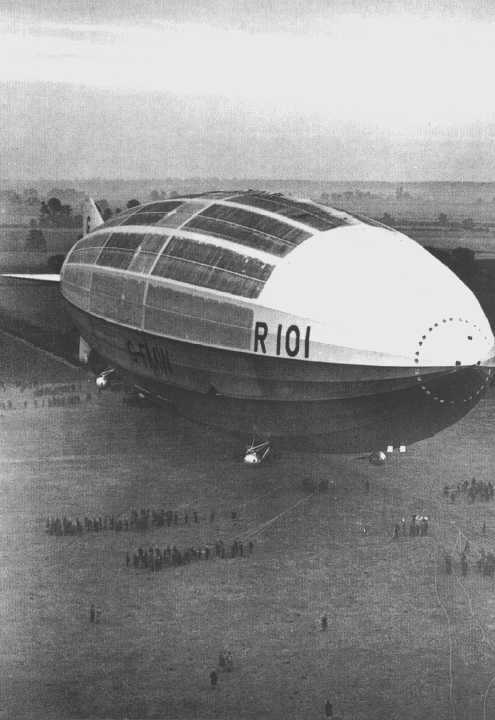
click to enlarge
It was at 06.30 on
the 1st October that the R101 emerged from the shed and was secured
to the mast. The new ship having a more elongated look as she had
been extended by some 35 feet with the new bay. At the same time, the
R100 was removed from Shed No 2, and walked in to the next door shed,
No.1 where she too was to be altered by having a new bay installed to
obtain more lift. It was the last time the outside world would see
the R100.
The R101 moored
serenely to her Cardington, the crew were busy making preparations
for a full 24 hour trial flight. A permit to fly had been issued and
a full report in to the new ship would be submitted later, a draft
having been prepared. The permit to fly had been granted after a
"good deal of general thinking and comparison on limited information
has been required in reaching our conclusion" noted Professor
Bairstow, who issued the permit.
Final Trial Flight
The R101 slipped her
mast at 4.30pm on 1st October with the plan to fly a 24 hour
endurance flight to complete the engine and other trials. It was
noted however, and agreed by officers, Reginald Colemore (Director of
Airship Development - DAD) and the AMSR that if the ship behaved well
and Major Herbert Scott, one of the most experienced airshipmen in
the UK, was satisfied during this flight then they could curtail the
flight to less than 24 hours.
The ship left
Cardington and headed south to London then turned east following the
Thames and out across Essex. She spent the night over out over the
North Sea. From those on board it was noted that the atmosphere was
quiet and serene. Due to the early failure of an engine cooler in the
forward starboard engine it was impossible for the ship to make a
full speed trial. During this flight the conditions were noted as
"perfect" and that all other items in the ship behaved perfectly.
Even though there was not time to make formal reports it was noted
that the ship handled and the ship appeared to be much better in the
air than before. It was with this that it was agreed to curtail the
flight and head for home at Cardington. The ship returning to the
mast at 09.20 on Thursday 2nd October. The ship had been in the air
for just over 17 hours in smooth flying conditions.
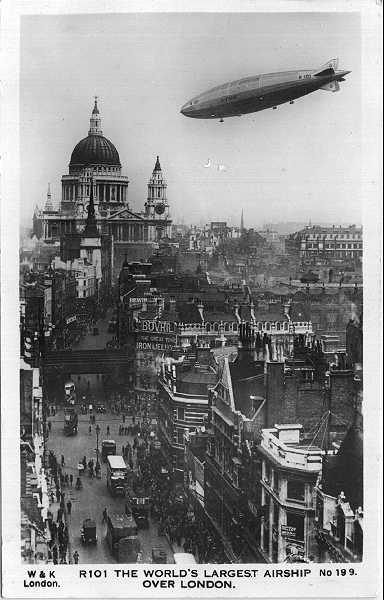
click to enlarge
Important things were
noted by the crew following this flight. Captain Irwin had made
special notice of all the concerns before the alterations. He noted
that there was practically no movement in the outer cover; all
sealing strips appeared to be secure, no leaks were observed in the
gas valves; the movement of the gas bags was so slight that it was
barely perceptible; and the padding was secure. All other items were
found to be in good order and he was satisfied with the independent
inspection which had been carried out on the ship.
The senior members of
the crew, technical office along with the DAD held conference on the
Thursday evening and discussed the decision for a flight to India. It
was noted that a longer trial whereby full speed testing could have
been carried in adverse condition was normally essential before
trying for such a long voyage. It was noted that a full speed trial
was not recommended during the India flight due to the chance of
failure. It had not been calculated at this stage state of the
engines with the new redesign of the ship. Also the risk of engine
failure would mean putting the whole voyage in jeopardy, and hence it
was deemed that cruising speed would be the maximum recommended speed
for the journey.
Even though pressure
had been put upon the crew and all involved with the R101 by the Air
Minister by suggesting that he must go to India and back in time for
the Imperial Conference due on the 20th October 1930, there was one
note on the 2nd October by Lord Thompson advising that "You mustn't
allow my natural impatience or anxiety to start to influence you in
any way. You must use your considered judgment."
Final Flight -
Saturday 4th October 1930.
click on the links in the table to see maps
With the decision
made that the India flight take place, there were two further days of
final preparation. The ship remained on the mast and the crews busied
themselves to make this momentous voyage. Of course all staff were
keeping an eye on the weather conditions to ensure that the ship
would be able to make the voyage in the suggested time allowed and
didn't want to be inhibited by the problems all airships suffered
with the natural elements. Giblett the meteorological officer had
been providing the Officers with updates on the weather forecasts
over the last few days, and the route was selected on his
information.
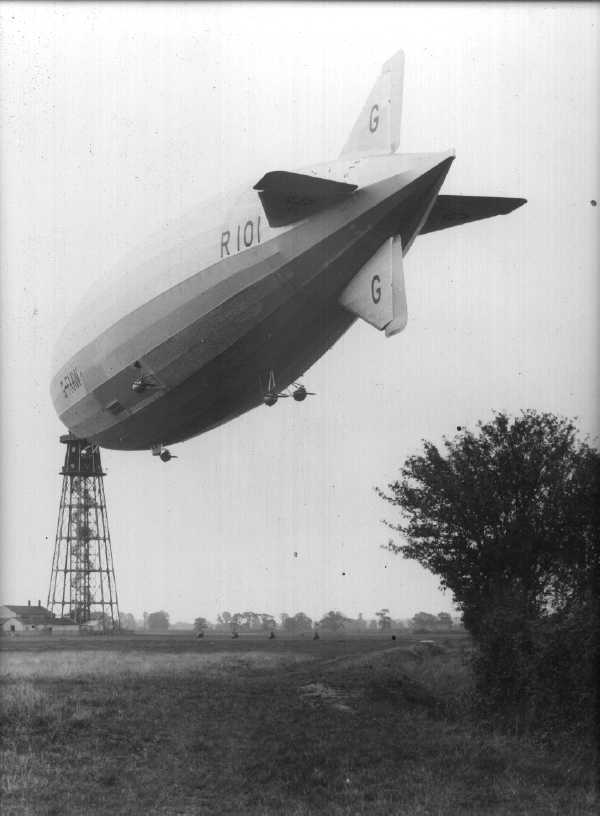
click to enlarge
Another weather
conference was held on the morning of the 4th October and it was
noted that the weather conditions over northern France were becoming
cloudy with moderate winds. It was agreed that the ship would depart
between 4pm and 8pm that evening. Two further forecasts were issued
to the ship during the day. These indicated that the weather
conditions over Cardington and Northern France would begin to
deteriorate during the evening, however it was noted that the wind
conditions would not increase significantly. These forecasts, even
thought not particularly good were not bad enough to cancel the
voyage. The decision was made to hurry the passengers on board,
complete the loading of the ship, and begin the trip in order to be
pass the worst weather.
.At 6.24pm the R101
left the Cardington mast in misty fine rain and darkness. The lights
from the promenade deck and searchlights from the mooring mast
illuminating the ship. As the ship was fully loaded with fuel to make
it to the first stop, Egypt, it was noted that 4 tons of ballast had
to be dropped before the ship gained more height. The R101 cruised
passed the sheds, and then headed west towards Bedford to salute her
home town. The ship passed around the town and then headed south east
towards London. The ship was flying in her cruising height of 1,500ft
just below the cloud base and by 8pm the R101 was flying over London.
A wireless message
from the ship was sent at 8.21pm:
"Over London. All
well. Moderate rain. Base of low clouds 1,500ft. Wind 240 degrees
[west south west] 25mph. Course now set for Paris. Intend to proceed
via Paris, Tours, Toulouse and Narbonne."
An hour later the
R101 was requesting the Meteorological Office at Cardington to
wireless a forecast of the weather expected from Paris to Marseilles
"with special reference to wind and cloud".
At 9.47pm the
following message was sent :
"At 21.35 GMT
crossing coast in the vicinity of Hastings. It is raining hard and
there is a strong South Westerly wind. Cloud base is at 1,500 feet .
After a good getaway from the Mooring Tower at 18.30 hours ship
circled Bedford before setting course. Course was set for London at
18.54. Engines running well at cruising speed giving 54.2 knots.
Reached London at 2000 hours and then set course for Paris. Gradually
increasing height so as to avoid high land. Ship is behaving well
generally and we have already begun to recover water ballast."
It was noted that
with the loss of ballast at the beginning of the flight, the crew
were more than confident that the water recovery system would
replenish the supplies. The R101 was fitted along the top of the
envelope with catchments arrangements by which, when rain fell, water
could be recovered to increase ballast and so compensate for the loss
of weight arising from the consumption of fuel. It is noted that at
this point the R101 crew did not consider the ship to be heavy as
original sources suggested.
The Channel crossing
took two hours for at 11.36 pm the ship reported :
"Crossing French
coast at Pointe de St Quentin. Wind 245 true. 35mph"
It is noted that the
60 miles crossing was well know by Squadron Leader Johnson who had
flown the route many times between London and Paris. It is also of
note that the wind speed was increasing in velocity at this time. It
was estimated that at the time of crossing the channel the R101 was
at a height of between 700 to 800 feet. It was later noted that the
First Officer, Atherstone took over the elevator wheel and ordered
the coxswain not to go below 1,000ft.
From 11.00pm to
02.00am the crew changed watches, R101 continued on it's usual
watch-keeping status.
At 00.18 the R101
sent out the following wireless message :
"To Cardington from
R101.
2400GMT 15 miles SW
of Abbeville speed 33 knots. Wind 243 degrees [West South West] 35
miles per hour. Altimeter height 1,500feet. Air temperature 51degrees
Fahrenheit. Weather - intermittent rain. Cloud nimbus at 500 feet.
After an excellent supper our distinguished passengers smoked a final
cigar and having sighted the French coast have now gone to bed to
rest after the excitement of their leave-taking. All essential
services are functioning satisfactorily. Crew have settled down to
watch-keeping routine."
This was the last
message from the R101 giving the speed and position of the ship. The
ship continued to send out directional signals for the purpose of
checking her position or testing the straight of the signals, by
Directional Wireless. The last directional signal addressed to
Cardington was at 1.28am. A final signal was sent to the Croydon
Station and relayed via ship at Le Bourget 01.51am and acknowledged
by the R101 at 01.52am. That was the last signal ever sent by the
R101.
At 02.00pm the watch
changed as with normal routine on the ship, still nothing was
reported wrong with the ship at this time. It can be assumed that had
this been noticed then the Captain would have had this signalled back
to base. Also if anything had been noticed at this time then the
Captain would not have allowed the men on duty to stand down and pass
over to the new watch. Evidence of engineer Leech at the Inquiry
confirmed the situation that Leech was off duty and enjoying a smoke
in the smoking room between 01.00am and 02.00am, when Captain Irwin
came in to the room and spoke to him and the Chief Engineer. The
Captain made no remarks about the ship except that the after engine
continued to run well.. Mr Gent, Chief Engineer, later turned in and
Leech went and made inspection of all the engine cars. He found them
all to be running well and returned to the smoking room.
At 02.00am the ship
reached Beauvais and passed to the east of the town. At this time
witnesses suggested that the ship was beginning to have difficulty
with the gusting winds. Some suggested that the promenade lights
became obscured and early suggestions were made that the ship was
rolling in the winds however no amount of rolling would explain this
and it seems probable that the lights were obscured by intervening
cloud.
From survivor
accounts at 02.00am the ship made a long and rather steep dive,
sufficient enough to make the engineers loose balance and to cause
furniture in the smoking room to slide. It is estimated that a rent
occurred in the rain soaked upper part of the nose, causing the
forward gas bags to become exposed to the elements and thus damaged
by the gusting wind. The loss of gas at this point could have led to
the loss of control of the ship. Also the ship was travelling towards
the notorious Beauvais ridge which was well know by aviators for it's
dangerous gusting wind conditions. The loss of gas at the forward
part of the ship, combined with a sudden downward gust of wind would
have forced the nose down. Calculations taken by the University of
Bristol in 1995 provides evidence that the maximum downward angle was
at 18 degrees in this first dive through a time span of 90 seconds.
The crew in the
control car would have tried to correct this and pulled the elevator
up to try to counter this downward angle. In the next 30 seconds the
ship pulled out of the forced dive and the crew were managing to
steady the ship. Flying at a nose up angle of 3 degrees enabling the
ship to try and regain some of the aerodynamic forces. However it was
realised that the elevator was hard "up" and yet the crew knew that
the nose was only just some 3 degrees above the horizon, this meant
that the nose was now extremely heavy and hence a serious loss of gas
from the forward bags would have occurred.
The Captain then rang
the order for all engines to reduce speed from the original cruising
speed, if not to stop them. The bells were heard and acted on by the
crew as evidence of the survivors confirmed. The Chief Coxswain,
Hunt, moved aft from the control car and to the crews quarters. At
this point he passed crew member Disley, and warned by saying "We're
down lads". This famous comment by one of the most experienced
airship crew members can be seen that the R101 at this point was not
going to be able to continue with it's existing difficulties, and
that an executive decision had been made to put the ship in to
emergency landing stations.
Just after this point
the ship moved in to a second dive. It is calculated that at this
point the R101 was now only at about a height of some 530 feet which
for a vessel of 777ft long was a precarious one, and so any rapid
oscillation of the ship, which had already occurred, would have
caused it to fail. Rigger Church was ordered to release the emergency
ballast from the nose of the ship and was on the way to the mooring
platform when he felt the angle of the ship begin to dip once more
from an even keel. The ship began to drop again through a downward
angle and at this point the nose impacted with the ground. Evidence
from the official inquiry noted that the R101's ground speed had
reduced to almost that of a perfect landing. The impact of the R101
with the ground was very gentle, and it was noted that the forward
speed of the ship was only 13.8 mph. The ship bounced slightly moving
forward some 60ft and then settled down to the ground. The survivors
recall that a "crunch" was heard and the the ship levelled. There was
no violent jarring from the impact. Evidence following the crash
confirms this as the only impact markings in the ground were a 2ft
deep by 9ft long groove which was cut by the nose cone. Soil was
later found in the nose cone. Also the starboard forward engine had
struck the ground with the propeller still revolving and grooves were
made by this, and the engine car had been twisted completely around
on it's struts.
After the impact, the
fire broke out. The most probably cause of this is the starboard
engine car was twisted around and thus hot engine which came in to
contact with the free gas from the rents in the forward gas bags. The
fire immediately consumed the ship causing each gasbag from the
forward to after part of the ship to explode. The force of the
explosions was noted by the position of the gas valves and the damage
to the framework of the ship. The outer cover was immediately
consumed in the ensuing inferno.
Of the crew and
passengers only 8 men were able to escape from the wreck.
Foreman Engineer J
H Leech - sitting in the smoking room at the time of the impact
managed to be saved by the bulkhead of the accommodation collapsing
from above and being held by the top of the settee in the smoking
room. He was able to escape through the side of the damaged wooden
walls of the smoking room and out through the framework to and
through the cloth outer cover of the ship to safety.
Engineers A V
Bell, J H Binks, A J Cook V Savory were in their respective
engine cars which were positioned outside the main hull, and hence
when the ship landed were able to escape through the windows of the
engine cars and run out away from the ship.
Rigger W G Radcliffe survived
the crash and worked his way out of the wreckage but later died in
the hospital from his injuries.
Wireless Operator
A Disley who was asleep in the crews' quarters was awakened as
his bunk was positioned in the same forward direction as the ship,
and thus awoke when he felt the curious angle of the first dive. He
felt the ship come out of the first dive and to an even keel and the
to a nose up angle. At the same moment Hunt passed through the crews
quarters and advised them of the situations and carried on through.
At this point Disley heard the telegraphs ring out in the ship. The
electrical switchboard was close at hand and he started to get out of
his bunk and to cut off the electric current to the ship. There were
two field switches and he recalls tripping on one of them. He did
this as he knew that in any aircraft crash there may be the chance of
fire. During this action the ship went in to it's second dive and he
was just about to switch the second one when the impact was heard and
the lights went out over the ship. Disley recalls that the impact was
not enough to unbalance him from his feet it was so gentle. Seconds
later he, like Leech was fighting he way through the wreckage to the
outside of the ship.
The last survivor was
Rigger Church, who later died of his injuries three days after
the crash. He was interviewed and gave the following statement.
"I would consider the
flight rather bumpy, but not exceptionally so. The second watch had
just come on and I was walking back when the ship took up a steep
diving attitude. At this moment I received an order to release the
emergency forward water ballast [1/2 ton in the nose] but before I
could get there the crash came."
The emergency ballast
was in the very nose of the ship and utilised most of the emergency
ballast, it could not be released from the controls in the control
car, and had to be jettisoned locally.
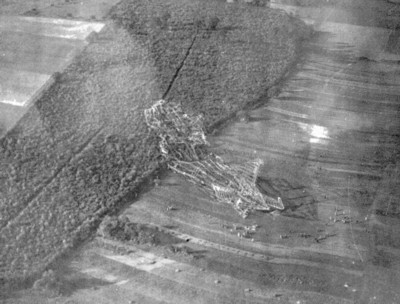
click to enlarge
The R101 came to rest
with the forward part of her nose in a wood of small trees and the
rest of her hull in a meadow. When getting away from the ship, both
Disley and Cook did notice some interesting facts. Disley noted that
even though the outer cover was burning, there was almost no cover
left on the top of the ship aft of frames 10 and 11. The ship
appeared to be a skeleton. Cook noticed that the underside of the
elevator still had outer cover on it and was positioned in a full up
position, suggesting that the coxswain was still trying to keep the
nose up on landing. The later inquiry noted that the number of turns
on the auxiliary winch drum confirmed this.
The survivors were
treated in the local hospital and the inquiry began the following
morning with the French authorities surveying the site and condition
off the wreck whilst the British investigators were flown in.
Messages were wired to England in the early hours of the morning
reporting the crash to a stunned British public.
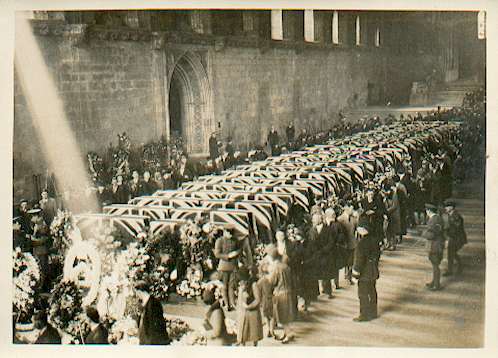
click to enlarge
Rigger Church was
later to die in hospital of his injuries and joined the other
victim's of the crash. Full state honours were given to the victims
as special trains were laid on to transport them from the crash site
to the channel. They were later loaded on to H.M.S. Tempest at
Boulogne and then carried to Dover where a special train took the
bodies to Victoria Station. From here they were carried in state to
Westminster Hall at the Palace of Westminster where they were laid in
state. From here the mourning public waited may hours to file past
the coffins to show respect. A memorial service was held at St Pauls
Cathedral on Saturday 11th October, after which the coffins were
taken by train to Bedford, then were walked the two miles to
Cardington Village, were a space had been prepared in the Village
Churchyard. All 48 dead were finally laid to rest in a special grave,
a final small service was undertaken with distinguished guests
including Hugo Eckener and Has Von Schiller, followed by a flypast by
the RAF flight. In 1931 a memorial tomb was completed and inscribed
with the names of the victim's .This memorial still dominates the
tiny churchyard to this day.
The Wreckage.
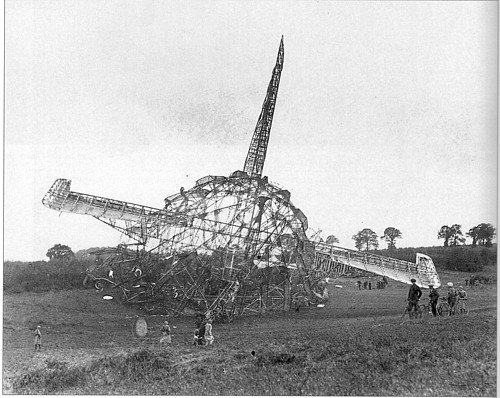
click to enlarge
The wreck of the R101
lay where it had fallen until well in-to 1931 becoming the haunt for
air accident investigators and day trippers to see the spectacle of
the near perfect skeleton of the once largest airship in the world.
Scrap contractors from Sheffield who were specialists in stainless
steel were employed to salvage what they could. It was noted in the
records of the the Zeppelin company that they purchased 5,000kgs of
duraluminium from the wreckage for their own use. Whether this was
used for testing and analysis or to re-cast and turned in-to the one
of the most well known airships ever, the "Hindenburg", is open to
further research and speculation. |
